Additive Manufacturing
- Additive Manufacturing is a process by which digital 3D CAD design data is used to build up a component layer by layer by spatially depositing material over a platform. AM enables the creation of complex geometries from the bottom-up, without many of the constraints of traditional manufacturing methods such as machining, molding, and casting
- The term 3D printing is increasingly used as a synonym for Additive Manufacturing(AM) but the latter is more accurate, because AM production techniques are clearly different from conventional methods of material removal
- AM processes are defined by their layer wise method of fabrication. Despite traits that are common among several AM processes, such as a vertically translating build platform or the use of powder feedstock, there is a wide process spectrum comprising different methods of material deposition, fusion and overall construction
- The below details summarizes AM processes according to 7 categories, based on the ASTM/ISO 52900:2015 standard. In each category, there are many names and acronyms for each process, frequently referring to specific machines or derivative commercial technologies. Importantly, the operating principles of all processes named within each category are similar regardless of the name or acronym used
1. Material Extrusion
Extrusion AM involves the spatially controlled deposition of thermoplastics. It is typically referred to as fused filament fabrication (FFF) or Fused Deposition Modeling (FDM). FDM is trademark of Stratasys Technology.
Extrusion is the most widely-known additive manufacturing process, as it is used by most consumer-grade machines, and many industrial AM systems.
Other names of the process:
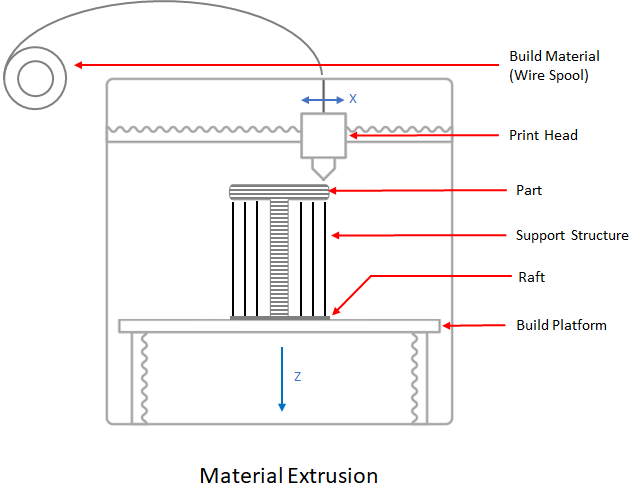
2. Photopolymerization
AM by photopolymerization is typically called stereolithography (SLA). The process involves spatially defined curing of a photoactive liquid known as photoresin, using a scanning laser or a high-resolution projected image, transforming it into a crosslinked solid.
Photopolymerization can produce parts with details and dimensions ranging from the micrometre- to meter-scales, and serves a variety of applications such as short run tooling, presentation models, dental models, hearing aids, etc.
Other names of the process
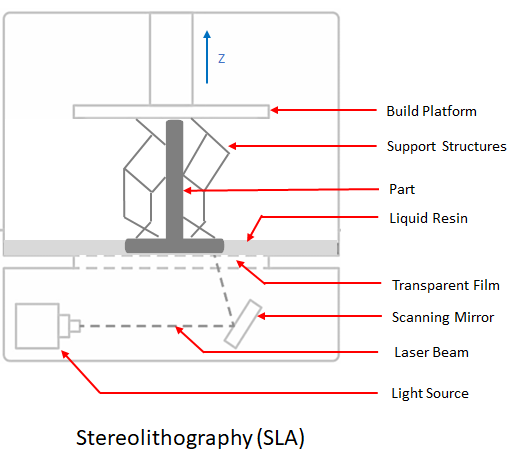
3. Powder Bed Fusion
Powder bed fusion (PBF) AM processes build objects by melting of powdered feedstock, commonly a polymer or metal.
PBF processes begin by spreading a thin layer of powder across the build area. Cross sections are then melted a layer at a time, most often using a laser, electron beam, or intense infrared lamps.
Other names of the process
- Selective Laser Melting (SLM)
- Direct Metal Laser Sintering (DMLS)
- 3D Metal Printing (3DMP)
- Selective Laser Sintering (SLS)
- High-Speed Sintering (HSS)
- Multi-Jet Fusion (MJF)
3.1 Selective Laser Sintering (SLS)
Powder bed fusion of polymers will be called selective laser sintering (SLS). As such, SLS systems typically print thermoplastic polymer materials, polymer composites, or in some cases ceramics.
3.2 Selective Layer Melting (SLM)
Powder bed fusion of metals is called selective laser melting (SLM) or electron beam melting (EBM). SLM systems can work with a diverse set of pure metals and alloys, however, in general these alloys must be compatible with the rapid solidification that occurs in SLM.
The build atmosphere must also be controlled according to the metal chosen, e.g. to prevent oxidation or unwanted alloying
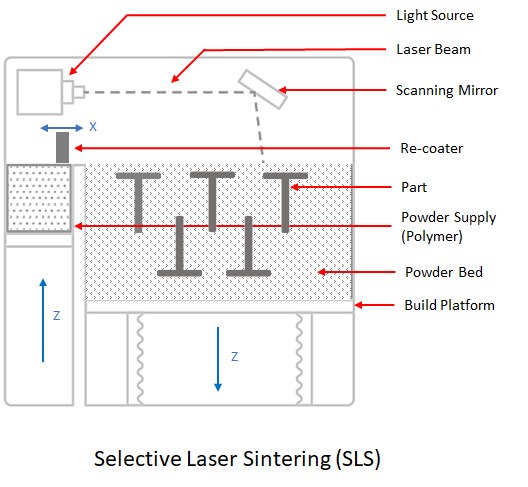
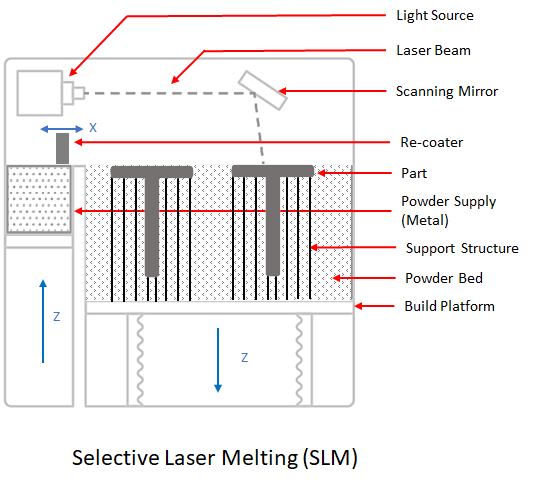
4. Material Jetting
AM by material jetting is accomplished by depositing small drops of material, with spatial control.
The operating principles of material jetting are similar to those of conventional inkjet printing, except here a 3D part is built instead of a 2D image. Rather, we may consider each layer of our 3D part to be a 2D image, and the part a stack of 2D images.
The print preparation converts the CAD design, along with specifications of material composition, color, and other variables to the printing instructions for each layer.
Other names of the process
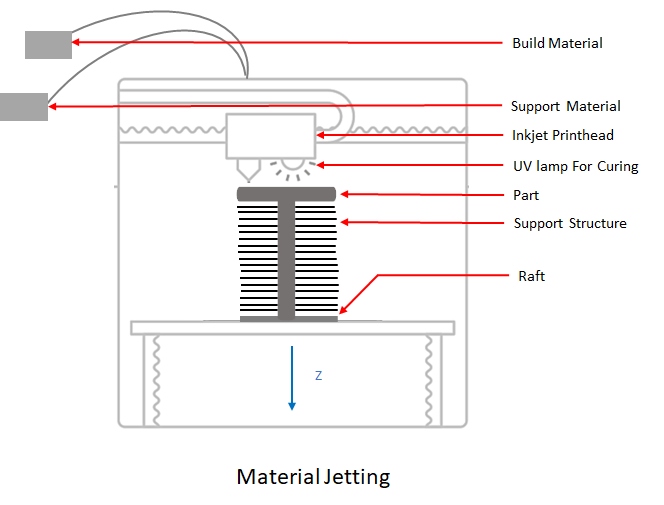
5. Binder Jetting
AM by Binder Jetting involves inkjet deposition of a liquid binder onto a powder bed typically followed by sintering to densify the bound powder. Therefore, binder jetting combines physics of other AM processes (analogous to SLS/SLM) and inkjet printing.
A printhead that jets droplets of liquid binder, connected to binder reservoir. Typically this moves via a planar gantry, and the inkjet modules within the printhead contains thousands of simultaneously operating nozzles.
Binder jetting is compatible with a wide variety of materials including sand, metals and ceramics.
Other names of the process

6. Directed Energy Deposition
Instead of using a powder bed, the DED process uses a directed flow of powder or a wire feed, along with an energy intensive source such as laser, electric arc, or electron beam.
DED is a direct-write process where the location of material deposition is by movement of the deposition head; this allows large metal structures to be built without the constraints of a powder bed.
Other names of the process
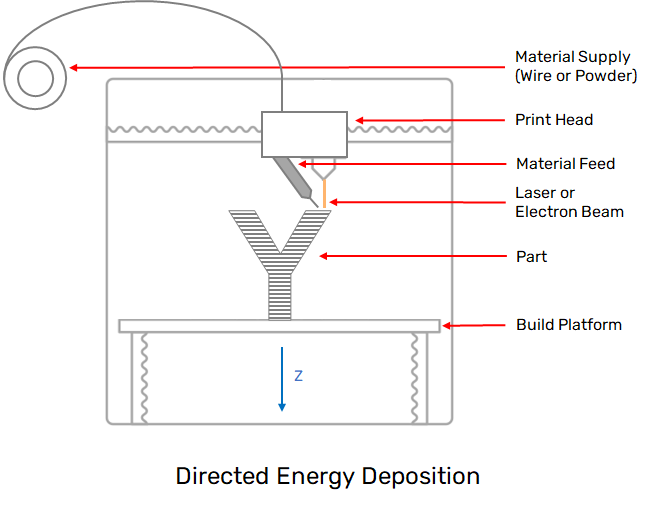
7. Lamination
Lamination AM, formally known as Laminated Object Manufacturing (LOM), is the process whereby consecutive layers of sheet material are consecutively bonded and cut in order to form a 3D structure. Importantly, methods of sheet application, bonding, and cutting may differ according to the specific implementation of LOM.
Other names of the process
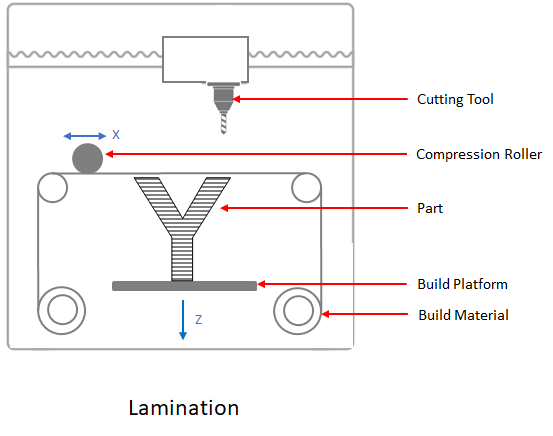
 3D SculpLab
3D SculpLab